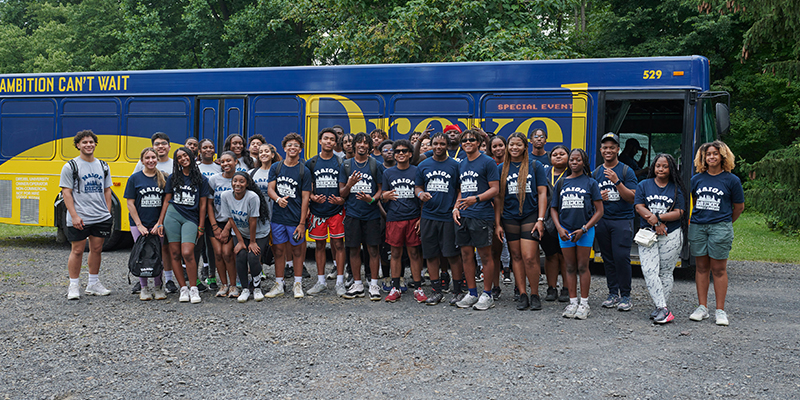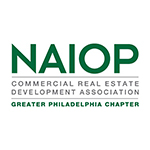Note: The NAIOP-Drexel Summer Program is a partnership between NAIOP Greater Philadelphia and Drexel University. The program, which just celebrated its fifth summer, brings together 30 high school rising juniors and seniors of color for a 10-day immersive experience, exposing them to nearly every aspect of commercial real estate. This five-part blog series seeks to deliver a little bit of that experience through the eyes of the students and their college-level ambassadors as well as the faculty and staff of both organizations who work year-round to plan and execute the program.
Chapter 1
It began as most programs do when young people don’t know each other: quietly. Lots of looking at phones and working to appear nonchalant. They arrived from Pennsylvania, New Jersey, New York, Delaware, Virginia and Texas, their parents dropping them off at the dorm rooms of Drexel University and hugging them goodbye. The students, many on a college campus for the first time, had lugged their belongings to their rooms, tentatively meeting their roommates as they unpacked, not knowing what to expect. It was “real estate camp” – how exciting could it be?
Plot twist: they weren’t beginning with a real estate-oriented program. Instead, still tentative, they boarded a bus and headed to a ropes course where, for the next three hours, they climbed, zipped, wobbled and gripped their way across courses, cheering on those whose nerves were high, helping each other over obstacles and celebrating successes.
“We completely heard a difference in the group when they reboarded the bus,” said photographer Ralph “Ozzie” Oswald III. “They couldn’t stop talking about the experience. It broke the ice.”
Immediate team building is critical to the success of the program, according to Sarah Maginnis, executive director of NAIOP Greater Philadelphia, which conceived of the program in 2018. “Ten days sounds like a long time, but it’s not, especially when you consider how much ground there is to cover. Each day is packed – there is classroom work, property tours, professional panels, software training, and much more. We want them to be in a frame of mind to pull everything out of it they can.”
One young man shared that not only was this the first time he’d stayed on a college campus, but it was also the first he’d visited, and it was a lot to take in at first. “I’m a little worried I could get lost,” he said as he walked quickly to stay with the group.
Aubrey C. of Philadelphia,, 18, who attends Springside Chestnut Hill Academy, was one of a few who attended knowing a little more. “My sister came through the program before me, and I was more excited than anything else. I want to be studying real estate in college in any way I can – such as through internships – and I want to get my real estate license, so I knew this could get me one step closer.”
After dinner in the dining hall – “the food was so much better than I expected” shared a student – they returned to their dorm and met with their program “ambassadors,” a group of college students selected to help the students stay on course.
“Our job is to keep the students on schedule,” said Arianna C., 19, of Philadelphia and a rising sophomore at Drexel who served as a program ambassador. “For many this is their first independent experience out of their homes, and we are here to listen, make sure they get where they need to go, and have fun.”
It took some work, but most of the students were so tired from travel, nerves and the ropes course that “lights out” came more easily than one might imagine.
All photo credit to Ralph Oswald III.

NAIOP-Drexel Summer Program students walk to their first property tour at the newly completed Drexel University Health Sciences Building developed by Wexford Science & Technology, LLC. 
Pete Cramer, NAIOP Greater Philadelphia Board Member, who serves as Senior Director, Development at Wexford Science & Technology, LLC prepared students for a tour of the 450,000 square foot Drexel University Health Sciences Building, a $300M project that is 100% leased by Drexel for two schools, the College of Nursing and Health Professionals and College of Medicine. 
Students gather after the ropes course adventure, an ice-breaker program designed to teach teamwork and create camaraderie. 
Navigating the ropes course. 
Students hold the guide lines from the ground, keeping one of their peers safe in the trees. 
Working out the jitters on the ground through a series of teambuilding activities helps keep students safe on the ropes course. 
Adjusting to the helmet and safety harness. 
Arianna C, a Program Ambassador and student at Drexel University, celebrates with one of the high school students as she completes the course.
Read the second chapter, The Mirror Matters, about why having access to CRE professionals and programs as early as the summer before junior year of high school can make such a difference for students of color.
Read the third chapter, Hard Hats All Around, about the value of students participating in project tours and seeing CRE development in action.
Read the fourth chapter, Living the Learnings, about how the program provides real-world experience students can add to their resume.
Read the final chapter, A Race to the Finish, about the students’ experience competing in a case study competition.








